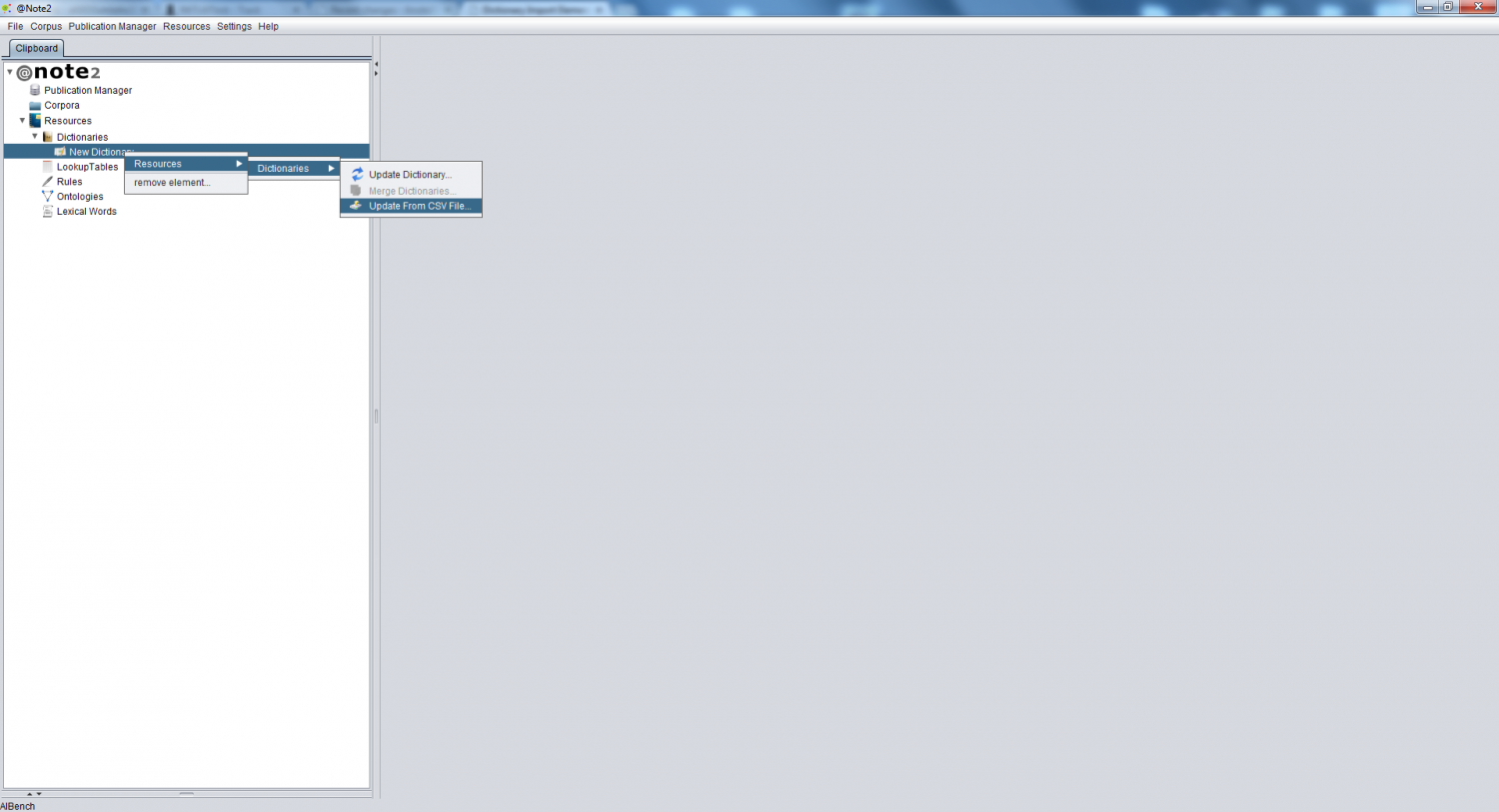Difference between revisions of "Dictionary Import Element From CSV File"
(→Configuration) |
Anote2Wiki (talk | contribs) |
||
| Line 4: | Line 4: | ||
== Operation == | == Operation == | ||
You can import information from a CSV file (see examples below) to add terms to a dictionary. | You can import information from a CSV file (see examples below) to add terms to a dictionary. | ||
| − | For that purpose, right click over the dictionary data-type and select the '''Update From CSV File''' option in the Dictionaries sub-menu | + | For that purpose, right click over the dictionary data-type and select the '''Update From CSV File''' option in the Dictionaries sub-menu: '''Resources - Dictionary -> Update From CSV File'''. |
[[File:Dictionary_Update_CSV_1.png|1500px|boarder|center]] | [[File:Dictionary_Update_CSV_1.png|1500px|boarder|center]] | ||
| + | |||
== Configuration == | == Configuration == | ||
| − | A GUI | + | A GUI is shown that allows to select the CSV file to load and select the options. |
| Line 18: | Line 19: | ||
Basic Options: | Basic Options: | ||
| − | * File: pressing the File button | + | * File: pressing the File button, you can browse and select the csv file from the file system (in black) |
* General Delimiter: The overall file delimiter that separates the contents of the columns in the file (in Blue) | * General Delimiter: The overall file delimiter that separates the contents of the columns in the file (in Blue) | ||
* Text Delimiter: The delimiter used to encapsulate individual text strings (if any) (in Green) | * Text Delimiter: The delimiter used to encapsulate individual text strings (if any) (in Green) | ||
* Synonyms Delimiter: The delimiter for separating synonyms within the list in the specified column (in Red) | * Synonyms Delimiter: The delimiter for separating synonyms within the list in the specified column (in Red) | ||
| − | * ExternalID Delimiter: The delimiter for separating | + | * ExternalID Delimiter: The delimiter for separating External Id instances within the list in the specified column (in maroon) |
* ExternalID Source Delimiter: The delimiter for separating ExternalIDs and Sources within the list in the specified column (in yellow). | * ExternalID Source Delimiter: The delimiter for separating ExternalIDs and Sources within the list in the specified column (in yellow). | ||
| − | * Default Value: Default value used to represent empty records | + | * Default Value: Default value used to represent empty records (in orange) |
* Column Options: Select the column for mandatory Term and Class and for not mandatory Synonyms and ExternalIds (in violet) | * Column Options: Select the column for mandatory Term and Class and for not mandatory Synonyms and ExternalIds (in violet) | ||
Revision as of 11:37, 23 January 2014
Contents
Operation
You can import information from a CSV file (see examples below) to add terms to a dictionary. For that purpose, right click over the dictionary data-type and select the Update From CSV File option in the Dictionaries sub-menu: Resources - Dictionary -> Update From CSV File.
Configuration
A GUI is shown that allows to select the CSV file to load and select the options.
Basic Options:
- File: pressing the File button, you can browse and select the csv file from the file system (in black)
- General Delimiter: The overall file delimiter that separates the contents of the columns in the file (in Blue)
- Text Delimiter: The delimiter used to encapsulate individual text strings (if any) (in Green)
- Synonyms Delimiter: The delimiter for separating synonyms within the list in the specified column (in Red)
- ExternalID Delimiter: The delimiter for separating External Id instances within the list in the specified column (in maroon)
- ExternalID Source Delimiter: The delimiter for separating ExternalIDs and Sources within the list in the specified column (in yellow).
- Default Value: Default value used to represent empty records (in orange)
- Column Options: Select the column for mandatory Term and Class and for not mandatory Synonyms and ExternalIds (in violet)
Examples
Next, we provide examples of csv files currently handled by @Note:
Example 1
General delimiter: TAB ( \t )
text Delimiter: NONE
Synonym Delimiter: Vertical Bar (|)
ExternalID Delimiter: Vertical Bar (|)
ExternalID Source Delimiter: Semi-colon (;)
GRF1 Protein - zma:542291;KEGG|P49106;IntAct GRF2 Protein 14-3-3-like protein GF14-12|GRF2a Q01526;SMR ATPA Protein ATP synthase subunit alpha, mitochondrial - CYPLXXVIII Protein Cytochrome P450 78A1|CYP78A1|CYP78 -
Example 2
General delimiter: Semi-colon ( ; )
text Delimiter: QUOTATIONS MARK (")
Synonym Delimiter: Vertical Bar (|)
ExternalID Delimiter: Vertical Bar (|)
ExternalID Source Delimiter: WHITE SPACE ( )
Column number
- Term: 2
- Class: 1
- Synonyms: 4
- ExternalID: 3
Default Delimiter: HYPHEN (-)
"Protein";"GRF1";"KEGG" "zma:542291"|"P49106" "IntAct";- "Protein";"GRF2;"SMR" "Q01526" ;"14-3-3-like protein GF14-12"|"GRF2a" "Protein";"ATPA";-;"ATP synthase subunit alpha, mitochondrial" "Protein";"CYPLXXVIII";-;"Cytochrome P450 78A1"|"CYP78A1"|"CYP78"
Results
In the end of this operation you can check the Resources update report


